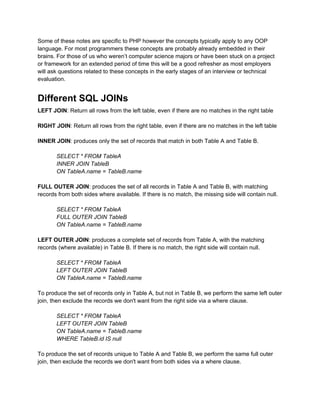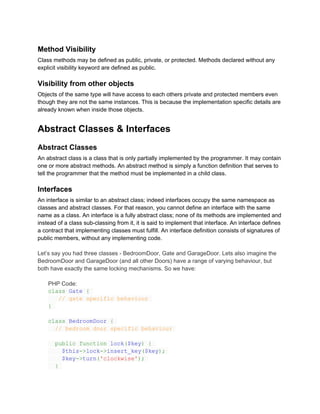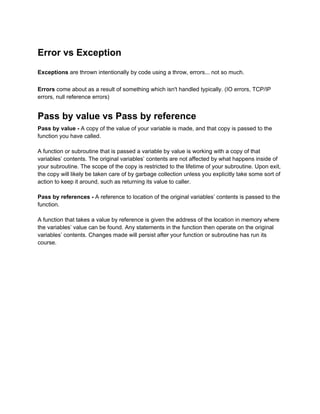SQL Joins
- 1. Some of these notes are specific to PHP however the concepts typically apply to any OOP language. For most programmers these concepts are probably already embedded in their brains. For those of us who werenĪ»t computer science majors or have been stuck on a project or framework for an extended period of time this will be a good refresher as most employers will ask questions related to these concepts in the early stages of an interview or technical evaluation. Different SQL JOINs LEFT JOIN: Return all rows from the left table, even if there are no matches in the right table RIGHT JOIN: Return all rows from the right table, even if there are no matches in the left table INNER JOIN: produces only the set of records that match in both Table A and Table B. SELECT * FROM TableA INNER JOIN TableB ON TableA.name = TableB.name FULL OUTER JOIN: produces the set of all records in Table A and Table B, with matching records from both sides where available. If there is no match, the missing side will contain null. SELECT * FROM TableA FULL OUTER JOIN TableB ON TableA.name = TableB.name LEFT OUTER JOIN: produces a complete set of records from Table A, with the matching records (where available) in Table B. If there is no match, the right side will contain null. SELECT * FROM TableA LEFT OUTER JOIN TableB ON TableA.name = TableB.name To produce the set of records only in Table A, but not in Table B, we perform the same left outer join, then exclude the records we don't want from the right side via a where clause. SELECT * FROM TableA LEFT OUTER JOIN TableB ON TableA.name = TableB.name WHERE TableB.id IS null To produce the set of records unique to Table A and Table B, we perform the same full outer join, then exclude the records we don't want from both sides via a where clause.
- 2. SELECT * FROM TableA FULL OUTER JOIN TableB ON TableA.name = TableB.name WHERE TableA.id IS null OR TableB.id IS null Static Keyword Declaring class properties or methods as static makes them accessible without needing an instantiation of the class. A property declared as static can not be accessed with an instantiated class object (though a static method can). For compatibility with PHP 4, if no visibility declaration is used, then the property or method will be treated as if it was declared as public. Because static methods are callable without an instance of the object created, the pseudo- variable $this is not available inside the method declared as static. Static properties cannot be accessed through the object using the arrow operator ->. Calling non-static methods statically generates an E_STRICT level warning. Like any other PHP static variable, static properties may only be initialized using a literal or constant; expressions are not allowed. So while you may initialize a static property to an integer or array (for instance), you may not initialize it to another variable, to a function return value, or to an object. As of PHP 5.3.0, it's possible to reference the class using a variable. The variable's value can not be a keyword (e.g. self, parent and static). Visibility The visibility of a property or method can be defined by prefixing the declaration with the keywords public, protected or private. Class members declared public can be accessed everywhere. Protected - can be accessed only within the class itself and by inherited and parent classes. Private - may only be accessed by the class that defines the member. Public - can be accessed from anywhere Property Visibility Class properties must be defined as public, private, or protected. If declared using var without an explicit visibility keyword, the property will be defined as public.
- 3. Method Visibility Class methods may be defined as public, private, or protected. Methods declared without any explicit visibility keyword are defined as public. Visibility from other objects Objects of the same type will have access to each others private and protected members even though they are not the same instances. This is because the implementation specific details are already known when inside those objects. Abstract Classes & Interfaces Abstract Classes An abstract class is a class that is only partially implemented by the programmer. It may contain one or more abstract methods. An abstract method is simply a function definition that serves to tell the programmer that the method must be implemented in a child class. Interfaces An interface is similar to an abstract class; indeed interfaces occupy the same namespace as classes and abstract classes. For that reason, you cannot define an interface with the same name as a class. An interface is a fully abstract class; none of its methods are implemented and instead of a class sub-classing from it, it is said to implement that interface. An interface defines a contract that implementing classes must fulfill. An interface definition consists of signatures of public members, without any implementing code. LetĪ»s say you had three classes - BedroomDoor, Gate and GarageDoor. Lets also imagine the BedroomDoor and GarageDoor (and all other Doors) have a range of varying behaviour, but both have exactly the same locking mechanisms. So we have: PHP Code: class Gate { // gate specific behaviour } class BedroomDoor { // bedroom door specific behaviour public function lock($key) { $this->lock->insert_key($key); $key->turn('clockwise'); }
- 4. } class GarageDoor { // garage door specific behaviour public function lock($key) { $this->lock->insert_key($key); $key->turn('clockwise'); } } Now, as you can see the two lock methods are exactly the same - duplication is evil! All Doors can be locked in the same way (but not Gates, these are bolted shut). We can eliminate this duplication by introducing an abstract class Door which implements this lock method for all of the concrete instances, eliminating the duplication. PHP Code: abstract class Door { public function lock($key) { $this->lock->insert_key($key); $key->turn('clockwise'); } } class BedroomDoor extends Door { // bedroom door specific behaviour } class GarageDoor extends Door { // garage door specific behaviour } Note that we don't necessarily have to use an abstract class to eliminate the duplication, we could just inherit from a normal concrete Door class that can be instantiated in its own right, depending on whether it makes sense for a Door to be instantiated on its own. Now, interfaces - interfaces can be used to specify a specific set of behaviour and that behaviour's API which classes can implement. As explained above, interfaces are best looked at as adjectives. Both doors and gates can be opened. Thats an interface right there: PHP Code: interface Openable { public function open() { }
- 5. } Both doors (through the abstract Door class) and the gate can be opened, so they can implement the interface. PHP Code: class Gate implements Openable { public function open() { if($this->is_locked()) { $this->unlock(); } $this->leftSide()->pullOpen(); $this->rightSide()->pullOpen(); } } abstract class Door implements Openable { // our abstract class defines the open function // as abstract as we open different types of door // differently abstract public function open() {} } class GarageDoor { public function open() { // implement here } } class BedroomDoor { public function open() { // implement here } } By specifying that we will implement the Openable interface, the class is bound by that contract and you will get an error if you forget to implement any of the methods in the interface. Finally, you can take advantage of type hinting in your methods - lets say you need to pass an object into another class to do something - the receiving class doesn't care what object we pass it as long as it can be opened. We can enforce this using type hinting: PHP Code: class Foo { public function openSomething(Openable $arg) { $arg->open(); } } Doing the above ensures that whatever gets passed to the openSomething() method will respond to open() because it implements the Openable interface.
- 6. Error vs Exception Exceptions are thrown intentionally by code using a throw, errors... not so much. Errors come about as a result of something which isn't handled typically. (IO errors, TCP/IP errors, null reference errors) Pass by value vs Pass by reference Pass by value - A copy of the value of your variable is made, and that copy is passed to the function you have called. A function or subroutine that is passed a variable by value is working with a copy of that variablesĪ» contents. The original variablesĪ» contents are not affected by what happens inside of your subroutine. The scope of the copy is restricted to the lifetime of your subroutine. Upon exit, the copy will likely be taken care of by garbage collection unless you explicitly take some sort of action to keep it around, such as returning its value to caller. Pass by references - A reference to location of the original variablesĪ» contents is passed to the function. A function that takes a value by reference is given the address of the location in memory where the variablesĪ» value can be found. Any statements in the function then operate on the original variablesĪ» contents. Changes made will persist after your function or subroutine has run its course.






